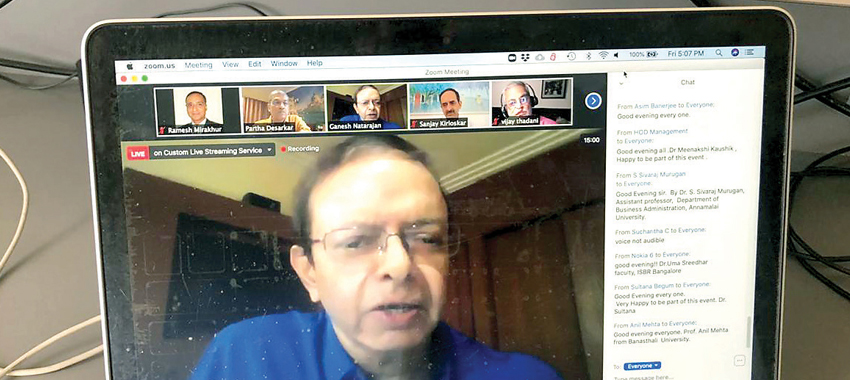The Trillion-Dollar Digital India

Two areas which have the potential to revive India’s economy are Education and Healthcare where digital platforms, standard and customised content delivery to educational institutions and health records and insurance will surely accelerate in the post COVID renaissance
The COVID pandemic has been wreaking havoc in many areas – 15 trillion dollars of economic value lost, nearly 200 million jobs likely to go by September and GDPs sliding to recession in Europe and potentially in the US and even India this year.
We have a shaky re-opening of the economy happening in India and normalcy is not likely to be restored very soon, in every company in almost every sector. The destruction of value is not just because of the lockdown impact on factories and businesses, but also because of the large migrant labour reverse migration from the cities, the disruption of supply and demand chains and even the natural change in demand patterns from “wants” to “needs” that we are likely to witness.
One discussion that was very prevalent in India through 2019 even as the demand slowdown started hitting many manufacturers was the disbelief at the five-trillion- dollar economy forecast for 2024. After COVID, the narrative has shifted entirely to struggling for a semblance of growth and the five trillion number is not even being discussed. However, one segment of that number was the trillion- dollar Digital India, and with digital reengineering and adoption accelerating, it is still conceivable that this milestone which was originally targeted for 2025 is eminently achievable.
Before we look at pathways to success, let us first break down the lofty trillion into understandable components. The architects of the plan are the Ministry of Electronics & Information Technology (MeitY) in a knowledge partnership with Mckinsey & Co. The principal contributor will be the IT and BPM industry, digital communications, electronics manufacturing, digital payments and e-Commerce, which has the potential to grow from an estimated 180 billion dollars in 2017-18 in value addition to approximately 400-505 billion in 2025. The new and emerging digital platforms and digitally enabled businesses, contribution to economic value less than 20 billion in 2017-18 would have the potential to reach 385-505 billion by 2025.
The story gets even more exciting when one considers the nine priority areas and the resultant thirty digital themes that add up to the large half-trillion number. Two areas which have the potential to far exceed the scale and scope envisaged are Education and Healthcare where digital platforms, standard and customised content delivery to educational institutions and health records and insurance will surely accelerate in the post COVID renaissance. Modernised IT infrastructure and reskilling of people for the new opportunities are also likely to be large focus areas for Government spending. The areas to watch would be the industry sectors of energy, manufacturing, agriculture and next-generation financial services, where the recent stimulus and supply-side streamlining should revive the outlook and hence the digital opportunities in the coming months.
“The future will also see big opportunities for public investments as well as public-private partnerships”
A large and possibly unanticipated opportunity for a true digital transformation is enabling digitally-enabled jobs in rural India so that the large numbers of migrant workers who have finally gone back home are able to find gainful employment. This can be supplemented with on line talent marketplaces to connect employers with job seekers and easy access to skills will enable a hundred million of our citizens to arm themselves for the opportunities of the future. These are just two of the thirty thematic opportunities outlined by the Digital India report.
The future will also see big opportunities for public investments as well as public-private partnerships. The most visible success story is the “India stack” for financial transactions – Aadhaar, Jan Dhan, UPI and Digilocker and now GeM to digitise the public procurement process. On the anvil are platforms for health, multi-modal logistics, land records, agriculture and document exchange and a GSTN digital platform to provide cheaper finance to MSMEs.
One unintended positive benefit of the COVID nightmare has been that in the absence of real funds to provide a fiscal stimulus like the US, UK, Germany, Korea etc have done, the Government has made long-overdue structural changes on the supply side – for finances, labour and credit, which if implemented well, can transform the landscape within which digital platforms can be deployed. All it now needs is the availability of large (100 MB) bandwidth to every citizen in the country ideally directly on their smart or character phones and in the interim in every village or at least each of the 250,000 plus “gram panchayats”. It is truly exciting to envisage a future where every able youth is digitally empowered and at least fifty per cent of those digitally independent, capably of becoming micro-entrepreneurs and take n local, regional and even national projects.
To make this dream of the trillion- dollar digital India happen, it needs many stakeholders that have been identified by the researchers – on the public side. On the private sector side, large IT companies, all India focused businesses, startups and investors and even NGOs and industry associations have a role to play in making this dream happen.